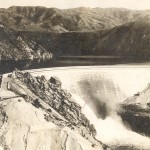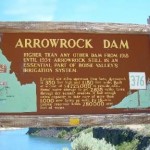Many years before my family moved to Boise, Idaho I had an interest in Arrowrock Dam. My grandmother gave me this “antique” picture postcard for my postcard collection. The card had been sent to her father in Iowa in 1922 from family friends who were visiting Idaho.
Arrowrock Dam is just over 20 miles from the City of Boise upstream on the Boise River. It was considered a rather fantastic engineering project of the time (1911-1915). It is only within the last decade that the several miles of road from Highway 21 up to the dam were paved. I’ve experienced the drive many times when it seemed too narrow, curvy and slow and the surface was often either hard-packed, washboardy dirt or mud. It amazes me that before more modern vehicles were in use it was such a popular tourist destination.
It’s not the dam itself that I want to tell you about. Around 2003 some work was done on the dam to update the valves used to control the flow of water. The old ensign valves were taken out and replaced by a newer type called a clamshell. One of the huge, rusty ensign valves was saved and is now on “display” near the dam. The valve is mounted so it can be viewed from all sides. The Bureau of Reclamation of the Department of the Interior had a large sign made with lots of information about the function and operation of the valves, how they were developed and where they were located on the dam structure.
I don’t question that the Bureau of Reclamation chose to preserve this piece of old technology for the public to view and learn about. I question where they chose to put it and whether or not it is really being preserved. Before one reaches the dam there is one of the familiar brown historical markers we see all over the state telling about Arrowrock Dam. There is space to pull off safely and read the marker and view the dam from a distance.
That seemed a likely place to put the valve, but that’s not where the valve is displayed. For people who just make the trip that far and don’t want to travel past the pavement, they will never know about or see see the valve display.
The road makes a long, unpaved switchback at the front of the dam. Then as it passes the dam it goes through a blasted out rock archway and continues beside steep rock face on one side and a steep slope down to water on the other. Many vehicles with boats and trailers in tow navigate this precarious section of the road in summer and winter to get to recreation areas behind the dam. A fairly large turnout was created to help with traffic flow. It is in that turnout that you will find the valve.
As I see it the display’s best function is to provide something to look at while using the turnout to let faster moving traffic pass. In the “not so useful” category:
- It takes up space in the turnout that vehicles use and need for safety.
- It’s a distraction from driving on a section of road that requires attention.
- Anything interesting and not in full sight placed along that road is subject to graffiti and is likely to become a target for gun shot. (The sign already has spray paint on it.)
- The wire rope surrounding the valve does not discourage or prevent people from climbing all over it.
- If a better idea for preserving it ever came about, its size, weight, and present mounting might be prohibitive in moving it elsewhere.
How the Boise River water flow is regulated and how our fantastic irrigation system was developed and continues to be maintained have helped Boise to exist and grow. Remembering and preserving a piece of the technology that helped that system for almost 100 years seems important. The choices made for the ensign valve display seem thoughtless.



I think your post affirms the place of the public historian. This could have been a really excellent piece of history to show 4th and 5th graders learning about Boise and Idaho history how the Boise River has and is an essential part of everyday life. While it might sound a little silly, I do think the valve is a piece of history that demonstrates the evolution Boise has undergone in terms of irrigation and agriculture. It just goes to show how crucial it is to have people with the ability to think critically about historic value! Thanks for sharing!
The Bureau of Reclamation took out ten (10) Ensign Valves at Arrowrock — the bottom row. One valve was placed near Arrowrock Dam as you pictured. However, another valve was placed at a park on Hill Road in Eagle, Idaho. A nice history was included, but the sun immediately destroyed the signage. Likewise, the signage at the Arrowrock display was also damaged by the sun. With the isolated area, it would be very difficult to monitor the display, and the wires were put their for the “normal” visitor to keep them off.
John, Historian, BOR